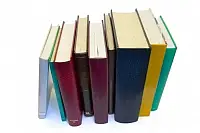Public domain books (and other writings)

When a book (or any written work) enters the public domain, you can copy and use it without getting permission or paying fees. That’s because public domain books are no longer — or never were — protected by copyright.
What can you do with public domain books? Republish them as they are, or add your own material to create new works. Recast them in new media, remix them with other works, translate them into new languages ... the possibilities are limited only by your imagination.
For example, Jane Austen’s 1816 novel Emma became a Gwyneth Paltrow movie in 1996. 1995’s Clueless was based, albeit loosely, on Emma, too. And countless works have been based on Shakespeare ... let’s see, Tom Stoppard’s Rosencrantz & Guildenstern Are Dead, to name one. And let’s not forget Walt Disney — he reworked the fairy tales of the Brothers Grimm (making them less, well, grim) and built an empire.
Here’s another case in point. Broadview Press recently republished an 1887 novel, She, by H. Rider Haggard, in its original serialized version. (It was a novel that both Freud and Jung loved, by the way, and it sounds fascinating.) And since it’s in the public domain, anyone can republish the original text, or write a screenplay based on it, or ... whatever.
You can also quote freely from public domain books and other writings. Author’s heirs and literary estates can be difficult to deal with when you want to quote from works that they control the rights to. The James Joyce estate is known for this (in fact, a Stanford University professor is suing the estate for copyright misuse). And the Joyce estate is hardly the only one to deny permission to quote, or to sue those who do. For example, the Samuel Beckett estate sues theater companies who stage unconventional versions of his plays.
But if a book or other written work is in the public domain you won’t have to pay extortionate permissions fees (which they sometimes are) and you won’t have to rely on fair use, an important but unpredictable defense to infringement. You can stage your play, or write your screenplay, or digitize the work and publish it online ... you can create stuff without needing a lawyer.
Are they public domain books?
The main ways written works enter the public domain are:
- the work wasn’t eligible for copyright in the first place;
- the work’s copyright has expired;
- the work was published before 1989 without a valid copyright notice; or
- the work’s author has dedicated the work to the public domain.
To learn how to tell if a work is in the public domain for one of these reasons, and more, take the tutorial on copyright and the public domain.
Avoiding problems with public domain books
Even if you think a work is in the public domain because it’s not eligible for copyright, or its copyright has expired, or it was published before 1989 without a valid copyright notice ... you’d be wise to make sure the entire work is free to use. If it’s a derivative work or a compilation, parts of the work may be protected by copyright.
What’s a derivative work?
A derivative work is one that is based on, or adapted from, a preexisting work. Common examples are a writing a screenplay based on a novel, recording an audio version of the novel, or a translating the novel another language. If someone creates a derivative work based on a public domain work, he or she can claim copyright in the changes made to the original work, provided the changes are original (that is, independently created — not copied) and aren’t trivial. But the public domain material remains free for others to use.
You can copy the original public domain material the derivative work is based on, but not the new material that has been added. For example, if someone else took Emily Brontë’s Wuthering Heights and wrote a screenplay based on it, you could copy the novel but not the new dialog and scenes. The new material would be copyrighted. For more information, see the derivative works page.
What’s a compilation?
A compilation is a work created when someone collects and assembles preexisting material in such a way that the resulting work as a whole constitutes an original work of authorship. Types of compilations include databases (fact compilations) and collective works such as encyclopedias, periodicals, and anthologies (where separate and independent works are assembled into a collective whole).
Anyone who creates a compilation of public domain works can claim copyright in their selection and/or arrangement of the material, as long as its minimally creative. (Basically, the person must exercise some judgement ... simply arranging the works chronologically or alphabetically wouldn’t suffice.)
You can copy the public domain material within the compilation, but not the selection and/or arrangement of the compiled work. For example, if someone made a compilation of Chekhov’s short stories that touch on the theme of unrequited love, you could copy the stories but not that particular selection of them. The selection, as a whole, would be a copyrightable work. For more information on compilations, see the tutorial’s compilation page.
Now that you know to be careful with derivative works and compilations, in case you come across them, be sure to check out the section on where to find public domain books.
